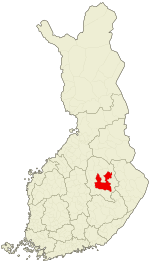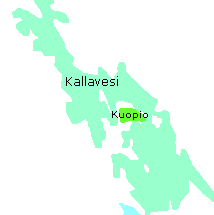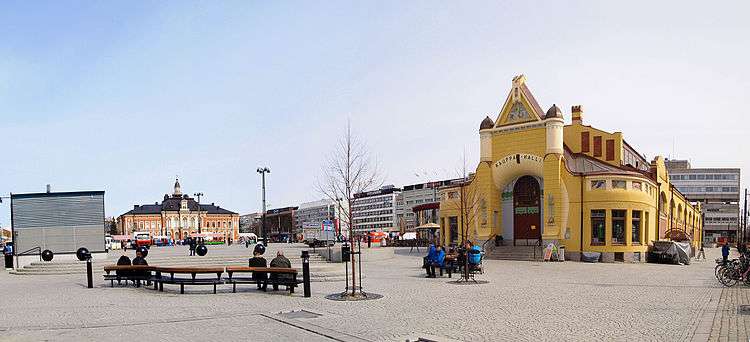Kuopio
| Kuopio City, Eastern Finland | ||
|---|---|---|
| City | ||
| Kuopion kaupunkiKuopio stad | ||
|
Kuopio viewed from the Puijo Tower | ||
| ||
 | ||
| Coordinates: 62°53′33″N 027°40′42″E / 62.89250°N 27.67833°ECoordinates: 62°53′33″N 027°40′42″E / 62.89250°N 27.67833°E | ||
| Country | Finland | |
| Region | Northern Savonia | |
| Sub-region | Kuopio sub-region | |
| Settled | 1653 | |
| Charter | 1775 | |
| Government | ||
| • City manager | Petteri Paronen | |
| Area (2011-01-01)[1] | ||
| • Total | 2,317.24 km2 (894.69 sq mi) | |
| • Land | 1,597.39 km2 (616.76 sq mi) | |
| • Water | 719.85 km2 (277.94 sq mi) | |
| Area rank | 32nd largest in Finland | |
| Population (2016-03-31)[2] | ||
| • Total | 112,158 | |
| • Rank | 9th largest in Finland | |
| • Density | 70.21/km2 (181.8/sq mi) | |
| Population by native language[3] | ||
| • Finnish | 97.8% (official) | |
| • Swedish | 0.1% | |
| • Others | 2.1% | |
| Population by age[4] | ||
| • 0 to 14 | 15.6% | |
| • 15 to 64 | 68.9% | |
| • 65 or older | 15.4% | |
| Time zone | EET (UTC+2) | |
| • Summer (DST) | EEST (UTC+3) | |
| Postal code | FI-70101 | |
| Municipal tax rate[5] | 19.5% | |
| Website | www.kuopio.fi | |
Kuopio is a city and a municipality located in the region of Northern Savonia, Finland. A population of 112,158[2] makes it the eighth biggest city in the country. The city has a total area of 2,317.24 square kilometres (894.69 sq mi), of which 719.85 km2 (277.94 sq mi) is water[1] and half forest. The population density is only 70/km2 (180/sq mi), but the city's urban areas are populated very densely (urban area: 1 618 /km²[6]), nationally second only to capital Helsinki (urban area: 1,690.0/km²[6]).[7]
Since 1969 Kuopio has grown extensively through municipality mergers. Kuopio’s population surpassed the 100,000 mark when the town of Nilsiä joined Kuopio at the beginning of 2013.
Name
There are several explanations behind the name Kuopio. The first is that in the 16th century, a certain influential person named Kauhanen in Tavinsalmi changed his name to Skopa and the people's pronunciation was Coopia and finally Cuopio. The second explanation is that it comes from the verb kuopia, meaning "paw", as when a horse paws the ground with its hoof. A third hypothesis is that it came from a certain Karelian man's name Prokopij, from Ruokolahti in the Middle Ages.[8] This is the most probable explanation, supported by the Research Institute for the Languages of Finland.
History
Kuopio was founded in 1653 by Governor Peter Brahe, but the official date is recognized as November 17, 1775, when King Gustav III of Sweden ordered the formal establishment of the city.[9]
The period of Russian rule (1809–1917) brought notable traffic connection development within Eastern Finland. The Saimaa Canal (1856) opened up a summer route towards the Baltic Sea, and the Savo railroad (1889) improved transport in winter.[9]
The municipality of Maaninka joined the city of Kuopio in 2015, town of Nilsiä in 2013 and Karttula[10] in 2011, like did Vehmersalmi in 2005, Riistavesi in 1973 and Kuopion maalaiskunta in 1969.[9]

Geography
The city is surrounded by Lake Kallavesi, and several parts of it are built on islands. Kuopio's ample waterfronts and islands are also utilized in the Saaristokaupunki (lit. Archipelago city) -project, the biggest residential area currently being built in Finland.[11] Saaristokaupunki will accommodate a total of 14,000 inhabitants in 2015. All houses will be situated no more than 500 metres (1,600 ft) from the nearest lakeshore.[12]
Transport
The city has a nationally unique feature in its street network, where every second street is practically a pedestrian and cycle street,[13] so called "rännikatu" (from Swedish gränd, alley). These streets provide pedestrians a calm environment aside from the main street traffic.[14] This setup dates back all the way to 1776 and the first town plan by Pehr Kjellman. Originally rännikatu, gränd (in Swedish) were created as a fire barrier to prevent a possible fire escalating in a city mostly built with wood.[15]
Kuopio is located along the Blue Highway, which is an international tourist route from Mo i Rana, Norway to Pudozh, Russia via Sweden.
Transport connections to Kuopio include Pendolino trains and air service from Kuopio Airport with Finnair, Blue1 and Finncomm (domestic, to Helsinki-Vantaa)
Education and business

| University | Students |
|---|---|
| University of Eastern Finland | 6 229[16] |
| Savonia University of Applied Sciences | 5 000[17] |
| HUMAK University of Applied Sciences | ~150 |
| Sibelius Academy | ~100 |
Kuopio has always been a city of education. Some of the first schools offering education in Finnish (such as the School for the Blind in 1871, and the Trade School in 1887) were established in Kuopio. Currently the most important institutions are the University of Eastern Finland, the Savonia University of Applied Sciences, Vocational College of Northern Savonia and the Kuopio department of the Sibelius Academy.
Kuopio is known as a strong center of health (e.g. it has the biggest yearly enrollment rate of medical students in Finland), pharmacy, environment, food & nutrition (all legalized Clinical and Public Health Nutritionists in Finland graduate from the University of Eastern Finland), safety (education in Emergency Services is centered in Kuopio[18]) and welfare professions, as the major organisations University of Kuopio (now part of the University of Eastern Finland since January 2010.[19]), Savonia University of Applied Sciences and Technopolis Kuopio are particularly oriented to those areas.
There are about 4,200 enterprises in Kuopio,[20] of which approximately 180 are export companies.[21] These provide about 45,000 jobs.[21]
People and culture

Kuopio is known as the cultural center of Eastern Finland. A wide range of musical (from kindergarten to doctorate-level studies) and dance education is available and the cultural life is active. Notable events include ANTI – Contemporary Art Festival, Kuopio Dance Festival, Kuopio Rockcock, Kuopio Wine Festival, Kuopio Marathon and Finland Ice Marathon in winter. A notable place, however, to enjoy the local flavor of Kuopio life and food is Sampo, a fish restaurant loved by locals and tourists as well.
Kuopio is known for its association with a national delicacy, Finnish fish pastry (Kalakukko), and the dialect of Savo, as well as the hill of Puijo and the Puijo tower. Besides being a very popular outdoor recreation area, Puijo serves also as a stage for a yearly World Cup ski jumping competition.
In inhabitants of Kuopio have a special reputation: they are known as jovial and verbally joking. Within the Savo culture, the onus is placed on the listener to interpret the story. People of the Kuopio region and Eastern Finland have always had many health problems and the mortality has been higher than on an average in Finland. Because of this, Eastern Finland has been a hotspot for Public Health studies. The North Karelia Project by the University of Kuopio in coordination with the National Public Health Institute and the World Health Organization, beginning in the 1970s was one of its first steps towards world class research.
During the 2000s (decade), Kuopio has placed very well in a number image, popularity and city-attractiveness surveys. In 2007 it was placed third, behind Tampere and Oulu.

Religion
The largest church denomination in Finland, Evangelical Lutheran Church has a diocese in Kuopio, which is shepherded by bishop Jari Jolkkonen.[22]
Kuopio is home of the Finnish Orthodox Church where its primate, archbishop of Karelia and all Finland Leo (Makkonen) is seated. This is an autocephalous jurisdiction affiliated with the Patriarchate of Constantinople. It is the only mainstream Orthodox faction to celebrate Easter on the Latin date. The late Archbishop Paul had been successful in producing literature of popular theology. The city is also the location of RIISA- Orthodox Church Museum of Finland.
Kuopio also has an Islamic mosque.[23] Muslims from various parts of the world and certain Finnish Muslims live in Kuopio.
The town is also home to the first Burmese Buddhist monastery in Finland, named the Buddha Dhamma Ramsi monastery.[24]
Climate
| Kuopio | ||||||||||||||||||||||||||||||||||||||||||||||||||||||||||||
|---|---|---|---|---|---|---|---|---|---|---|---|---|---|---|---|---|---|---|---|---|---|---|---|---|---|---|---|---|---|---|---|---|---|---|---|---|---|---|---|---|---|---|---|---|---|---|---|---|---|---|---|---|---|---|---|---|---|---|---|---|
| Climate chart (explanation) | ||||||||||||||||||||||||||||||||||||||||||||||||||||||||||||
| ||||||||||||||||||||||||||||||||||||||||||||||||||||||||||||
| ||||||||||||||||||||||||||||||||||||||||||||||||||||||||||||
Kuopio falls in the subarctic climate zone (Köppen "Dfc"), closely bordering on continental due to its warm summers. Winters are long and cold, with average highs staying below freezing from November until March, and summers are short and relatively mild. Most precipitation occurs in the late summer and early fall.
| Climate data for Kuopio Airport (1981-2010 normals, extremes 1959-present) | |||||||||||||
|---|---|---|---|---|---|---|---|---|---|---|---|---|---|
| Month | Jan | Feb | Mar | Apr | May | Jun | Jul | Aug | Sep | Oct | Nov | Dec | Year |
| Record high °C (°F) | 5.0 (41) |
9.2 (48.6) |
13.3 (55.9) |
21.9 (71.4) |
28.6 (83.5) |
31.1 (88) |
33.8 (92.8) |
33.2 (91.8) |
24.8 (76.6) |
16.0 (60.8) |
11.1 (52) |
8.6 (47.5) |
33.8 (92.8) |
| Average high °C (°F) | −6.0 (21.2) |
−5.7 (21.7) |
−0.2 (31.6) |
6.4 (43.5) |
14.1 (57.4) |
18.9 (66) |
21.8 (71.2) |
18.9 (66) |
13.0 (55.4) |
6.3 (43.3) |
−0.1 (31.8) |
−3.9 (25) |
6.96 (44.51) |
| Daily mean °C (°F) | −9.2 (15.4) |
−9.2 (15.4) |
−4.1 (24.6) |
2.0 (35.6) |
9.1 (48.4) |
14.5 (58.1) |
17.5 (63.5) |
15.0 (59) |
9.7 (49.5) |
4.1 (39.4) |
−2.0 (28.4) |
−6.7 (19.9) |
3.39 (38.1) |
| Average low °C (°F) | −12.6 (9.3) |
−13.0 (8.6) |
−8.0 (17.6) |
−2.2 (28) |
4.3 (39.7) |
10.3 (50.5) |
13.6 (56.5) |
11.7 (53.1) |
7.0 (44.6) |
2.1 (35.8) |
−4.1 (24.6) |
−9.7 (14.5) |
−0.05 (31.9) |
| Record low °C (°F) | −39.3 (−38.7) |
−37.0 (−34.6) |
−33.0 (−27.4) |
−20.9 (−5.6) |
−8.2 (17.2) |
0.1 (32.2) |
4.7 (40.5) |
2.7 (36.9) |
−4.9 (23.2) |
−15.0 (5) |
−27.6 (−17.7) |
−33.2 (−27.8) |
−39.3 (−38.7) |
| Average precipitation mm (inches) | 48 (1.89) |
36 (1.42) |
36 (1.42) |
30 (1.18) |
46 (1.81) |
67 (2.64) |
80 (3.15) |
75 (2.95) |
53 (2.09) |
56 (2.2) |
52 (2.05) |
51 (2.01) |
630 (24.81) |
| Average precipitation days | 11 | 9 | 9 | 7 | 9 | 10 | 11 | 11 | 10 | 11 | 11 | 11 | 120 |
| Source: Finnish Meteorological Institute [25] | |||||||||||||
Notable people
Sports in Kuopio

Kuopio bid for the 2012 Winter Youth Olympics, a youth sports festival in the tradition of the Olympics. It became a finalist in November 2008, but ultimately lost to Innsbruck, Austria. Kuopio's image as a small city with a large University and many active young people was considered a model of what the International Olympic Committee seeks for the Games.[26]
- KalPa (ice hockey)
- KuPS (football)
- Kuopion Taitoluistelijat (Figure skating)
- Puijon Hiihtoseura (skiing, ski jumping, nordic combined, biathlon)
- Puijon Pesis (pesäpallo)
- Kuopion Reippaan voimistelijat (gymnastics)
- Finland Ice Marathon (ice skating event)
- Kuopio Steelers (american football)
- Kuopio Skating club, Kuopion Luisteluseura KuLs (figure skating)
- Welhot (floorball)
- Linkki (basketball)
International relations
Twin towns — Sister cities
Kuopio is twinned with:
References
- Notes
- 1 2 "Area by municipality as of 1 January 2011" (PDF) (in Finnish and Swedish). Land Survey of Finland. Retrieved 9 March 2011.
- 1 2 "Ennakkoväkiluku sukupuolen mukaan alueittain, maaliskuu.2016" (in Finnish). Statistics Finland. Retrieved 31 March 2016.
- ↑ "Population according to language and the number of foreigners and land area km2 by area as of 31 December 2008". Statistics Finland's PX-Web databases. Statistics Finland. Retrieved 29 March 2009.
- ↑ "Population according to age and gender by area as of 31 December 2008". Statistics Finland's PX-Web databases. Statistics Finland. Retrieved 28 April 2009.
- ↑ "List of municipal and parish tax rates in 2011". Tax Administration of Finland. 29 November 2010. Retrieved 13 March 2011.
- 1 2 "Taajamissa asuu 84 prosenttia väestöstä" (in (Finnish)). Statistics Finland. 15 January 2008. Retrieved 7 January 2009.
Tiheimmin asuttu oli Helsingin keskustaajama, jossa oli 1 690 asukasta maaneliökilometrillä. Seuraavaksi tiheimmin asuttuja olivat Kuopion keskustaajama (1 618 as./maa-km2)
- ↑ Kuopio 2015: Jalankulku-, joukkoliikenne- ja autokaupunki. Finland’s Ministry of the Environment. p. 42. ISBN 978-952-11-2852-3.
- ↑ Archived 26 January 2010 at the Wayback Machine.
- 1 2 3 "History and basic data". Kuopio in Brief. City of Kuopio. Retrieved 2 November 2016.
- ↑ "Karttula sulautuu Kuopioon" & "Karttula ja Kuopio yhteen". Myöhänen, Pentti & Manner, Matias & Hartikainen, Jarno; Savon Sanomat. 1 July 2008. pp. 1 and 3.
- ↑ "Kuopion korkein asuinkerrostalo nousi harjakorkeuteen". Suomen Kiinteistölehti. 2008-10-16. p. 14.
- ↑ "Kallaveden syleilyssä". Saaristokaupunki. Kuopio. Retrieved 7 January 2009.
- ↑ WP2: Accessibility, Synthesis Report (PDF). Universell utforming. 26 March 2004. p. 14.
- ↑ Description of the Case Areas (PDF). VTT Technical Research Centre of Finland. 2 May 2002. p. 8.
- ↑ "Napoleon ja Kuopio: Kuninkaiden Kuopio". Memory of Northern Savonia. Museums of Northern Savonia. Retrieved 11 January 2009.
- ↑ "Key Data for 2007". University of Kuopio. 2007. Retrieved 9 January 2009.
- ↑ "In English". Savonia University of Applied Sciences. 2009. Retrieved 9 January 2009.
- ↑ Emergency Services College
- ↑ Steps leading to the establishment of the UEF
- ↑ Kuopion työpaikat ja elinkeinorakenne 1.1.2008 (PDF). Kuopion kaupungin yrityspalvelu. 2008. pp. 1–2.
- 1 2 "Elinkeinoelämä". City of Kuopio. 7 October 2008. Retrieved 9 January 2009.
- ↑ Koskinen, Jerri (6 May 2012). "Jari Jolkkonen vihittiin Kuopion piispan virkaan". Savon Sanomat. Retrieved 11 May 2012.
- ↑ "Kuopio Mosque".
- ↑ "Buddhist Channel | Buddhism News, Headlines | World | Burmese Buddhist monastery opens in Finland". Buddhistchannel.tv. 2009-01-05. Retrieved 2011-09-16.
- ↑ "Tilastoja Suomen ilmastosta 1981 - 2010". Finnish Meteorological Institute.
- ↑ Innsbruck and Kuopio Make Final Shortlist For 2012 Youth Olympic Winter Games Archived 8 January 2012 at the Wayback Machine.
- ↑ "List of Twin Towns in the Ruhr District" (PDF). Twins2010.com. Archived from the original (PDF) on 28 November 2009. Retrieved 2009-10-28.
- ↑ "Miasta Partnerskie Opola". Urzad Miasta Opola (in Polish). Archived from the original on 1 August 2013. Retrieved 2013-08-01.
- ↑ "Kuopio and Shanghai Pudong have signed a sister city agreement". City of Kuopio. 2012-07-20. Retrieved 24 August 2012.
External links
| Wikimedia Commons has media related to Kuopio. |
| Wikivoyage has a travel guide for Kuopio. |
- City of Kuopio – Official website (Finnish) (Swedish) (English) (German)
- KuopioInfo – Various resources about different areas of interest related to Kuopio History and Life (Finnish) (English) (German) (Russian) (Chinese)
- 360° panorama of Kuopio Marketplace
- Savonia University of Applied Sciences (English)
- University of Eastern Finland (English)
- Technopolis Kuopio (Finnish) (English) (Russian)
- Invest in Kuopio -factsheet (English)
- Kuopio Mosque
- Satellite picture by Google Maps


